brake MERCEDES-BENZ S-CLASS CABRIOLET 2019 Owner's Manual
[x] Cancel search | Manufacturer: MERCEDES-BENZ, Model Year: 2019, Model line: S-CLASS CABRIOLET, Model: MERCEDES-BENZ S-CLASS CABRIOLET 2019Pages: 518, PDF Size: 13.78 MB
Page 9 of 518
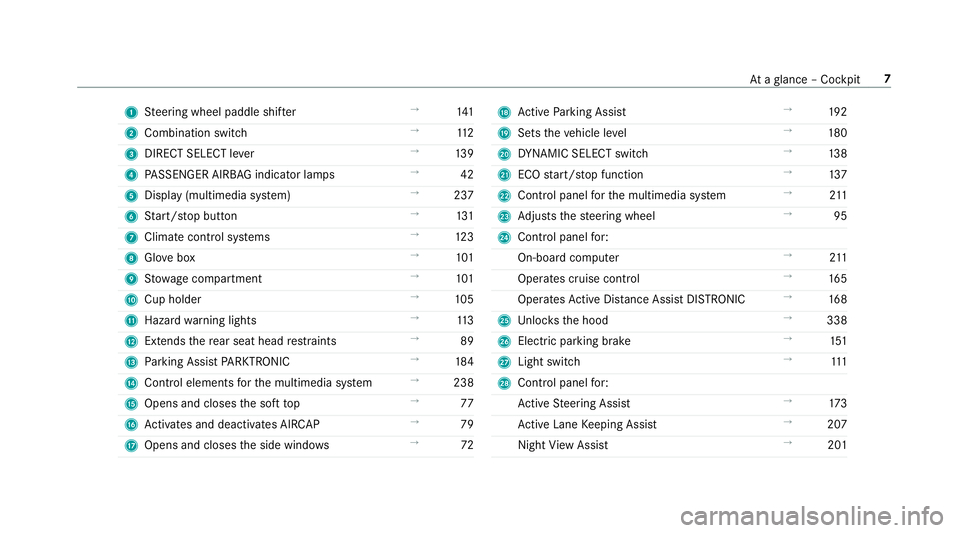
1
Steering wheel paddle shif ter →
141
2 Combination swit ch →
11 2
3 DIRECT SELECT le ver →
13 9
4 PASSENGER AIRB AGindicator lamps →
42
5 Display (multimedia sy stem) →
237
6 Start/ stop button →
131
7 Climate cont rol sy stems →
12 3
8 Glovebox →
101
9 Stow age compartment →
101
A Cup holder →
105
B Haza rdwa rning lights →
11 3
C Extends there ar seat head restra ints →
89
D Parking Assist PARKTRONIC →
184
E Control elements forth e multimedia sy stem →
238
F Opens and closes the soft top →
77
G Activates and deacti vates AIR CAP →
79
H Opens and closes the side windo ws →
72 I
Active Parking Assist →
19 2
J Sets theve hicle le vel →
180
K DYNA MIC SELECT switch →
13 8
L ECO start/ stop function →
137
M Control panel forth e multimedia sy stem →
211
N Adjusts thesteering wheel →
95
O Control panel for:
On-board computer →
211
Operates cruise control →
16 5
Operates Active Dis tance Assi stDISTRONIC →
16 8
P Unloc ksthe hood →
338
Q Elect ric pa rking brake →
151
R Light switch →
111
S Control panel for:
Ac tive Steering Assist →
173
Ac tive Lane Keeping Assist →
207
Night View Assi st →
201 At
aglance – Cockpit 7
Page 13 of 518
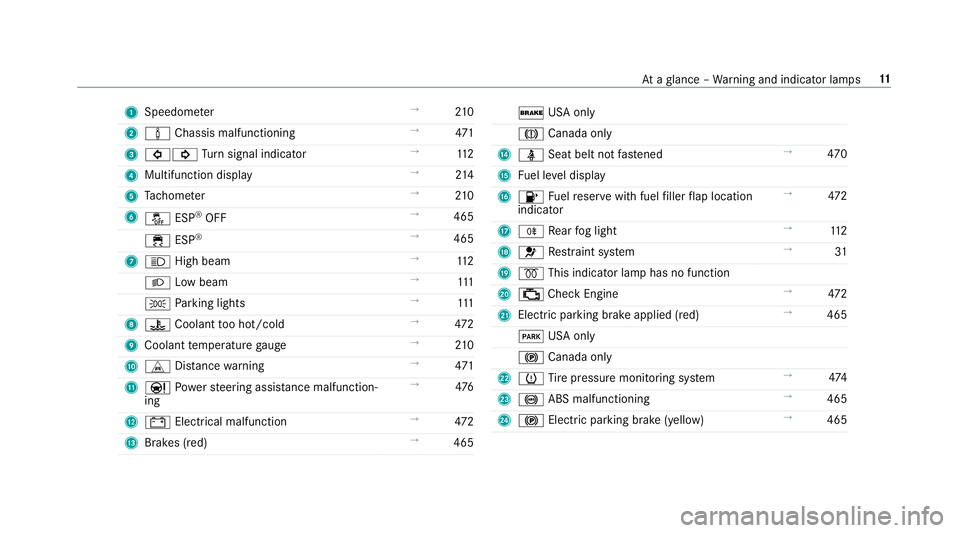
1
Speedom eter →
210
2 00CC Chassis malfunctioning →
471
3 003E003D Turn signal indicator →
11 2
4 Multifunction display →
214
5 Tach ome ter →
210
6 00BB ESP®
OFF →
465
00E5 ESP®
→
465
7 0057 High beam →
11 2
0058 Low beam →
111
0060 Parking lights →
111
8 00AC Coolant too hot/cold →
472
9 Coolant temp erature gauge →
210
A L Distance warning →
471
B 00CC Powe rst eering assis tance malfunction‐
ing →
476
C 003D Electrical malfunction →
472
D Brakes (red) →
465 0027
USA only
004D Canada only
E 00E9 Seat belt not fastened →
470
F Fuel le vel display
G 00B6 Fuelreser vewith fuel filler flap location
indicator →
472
H 005E Rear fog light →
11 2
I 0075 Restra int sy stem →
31
J 0028 This indicator lamp has no function
K 00B9 Check Engine →
472
L Electric pa rking brake applied (red) →
465
0049 USA only
0024 Canada only
M 0077 Tire pressure monitoring sy stem →
474
N 0025 ABS malfunctioning →
465
O 0024 Electric pa rking brake (yellow) →
465 At
aglance – Warning and indicator lamps 11
Page 22 of 518

*
NO
TEImpairment of the operating ef fi‐
ciency of there stra int sy stems from
ins talling accessory parts or from repairs
or we lding Airbags and Emer
gency Tensioning Devices,
as well as control units and sensors forthe
re stra int sy stems, may be ins talled in thefo l‐
lowing areas of your vehicle:
R Doors
R Door pillars
R Door sills
R Seats
R Cockpit
R Instrument clus ter
R Cen ter console
R Lateral roof frame #
Do not ins tall accessory parts such as
audio sy stems in these areas. #
Do not car ryout repairs or welding. #
Have afte rm arke t ins tallation of acces‐
sories car ried out at a qualified special‐
ist workshop. Yo
u could jeopardize the operating saf ety of your
ve hicle if you use parts, tires and wheels as well
as accessories releva nt tosaf ety which ha venot
been appr ovedby Mercedes-Benz. Saf ety-re le‐
va nt sy stems, e.g. the brake sy stem, may mal‐
function. Only use Mercedes-Benz Genuine Parts
or parts of equal qualit y.Only use tires, wheels
and accessories that ha vebeen specifically
appr ovedfo ryo ur vehicle model.
Mercedes-Benz Genuine Parts are subject to
st rict quality control. Each part has been spe‐
cially de veloped, manufactured or selec tedfor
Mercedes-Benz vehicles and fine-tuned forth em.
Therefore, only Mercedes-Benz Genuine Parts
should be used.
More than 300,000 dif fere nt Mercedes-Benz
Genuine Parts are available for Mercedes-Benz
models.
All auth orized Mercedes-Benz Centers maintain
a supply of Mercedes-Benz Genuine Parts for necessa
ryservice and repair work. In addition,
st ra tegically located parts delivery centers pro‐
vide forqu ick and reliable parts service.
Alw ays specify theve hicle identification number
(VIN) (→ page 408) when ordering Mercedes-
Benz Genuine Parts. Operator's Manual
This Operator's Manual describes all models and
all standard and optional equipment available for
yo ur vehicle at the time of this Opera tor's Man‐
ual going topress. Countr y-specific dif fere nces
are possible. No tethat your vehicle may not be
equipped with all features desc ribed. This is also
th e case for sy stems and functions releva nt to
saf ety. Therefore, the equipment on your vehicle
may dif fer from that in the descriptions and illus‐
trations.
The original pur chase agreement foryo ur vehicle
contains a list of all of the sy stems in your vehi‐
cle.
Should you ha veany questions concerning
equipment and operation, please consult an
authorized Mercedes-Benz Center. 20
General no tes
Page 28 of 518
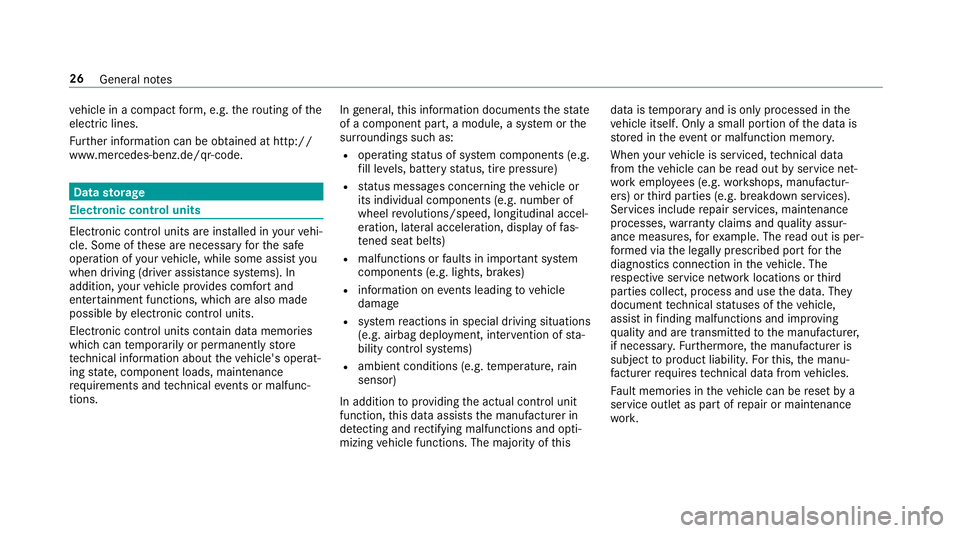
ve
hicle in a compact form , e.g. thero uting of the
electric lines.
Fu rther information can be obtained at http://
www.mercedes-benz.de/qr-code. Data
storage Electronic control units
Elect
ronic control units are ins talled in your vehi‐
cle. Some of these are necessary forth e safe
operation of your vehicle, while some assist you
when driving (driver assis tance sy stems). In
addition, your vehicle pr ovides com fort and
enter tainment functions, which are also made
possible byelectronic control units.
Elect ronic control units contain da tamemories
which cantemp orarily or permanently store
te ch nical information about theve hicle's operat‐
ing state, component loads, main tenance
re qu irements and tech nical events or malfunc‐
tions. In
general, this information documents thest ate
of a component part, a module, a sy stem or the
sur roundings such as:
R operating status of sy stem components (e.g.
fi ll le vels, battery status, tire pressure)
R status messages concerning theve hicle or
its individual components (e.g. number of
wheel revo lutions/speed, longitudinal accel‐
eration, lateral acceleration, display of fas‐
te ned seat belts)
R malfunctions or faults in impor tant sy stem
components (e.g. lights, brakes)
R information on events leading tovehicle
damage
R system reactions in special driving situations
(e.g. airbag deployment, inter vention of sta‐
bility control sy stems)
R ambient conditions (e.g. temp erature, rain
sensor)
In addition toprov iding the actual control unit
function, this data assists the manufacturer in
de tecting and rectifying malfunctions and opti‐
mizing vehicle functions. The majority of this data is
temp orary and is only processed in the
ve hicle itself. Only a small portion of the data is
st ored in theeve nt or malfunction memor y.
When your vehicle is serviced, tech nical da ta
from theve hicle can be read out byservice net‐
wo rkemplo yees (e.g. workshops, manufactur‐
ers) or third parties (e.g. breakdown services).
Services include repair services, maintenance
processes, warranty claims and quality assur‐
ance measures, forex ample. The read out is per‐
fo rm ed via the legally prescribed port forthe
diagnostics connection in theve hicle. The
re spective service network locations or third
parties collect, process and use the data. They
document tech nical statuses of theve hicle,
assist in finding malfunctions and impr oving
qu ality and are transmit tedto the manufacturer,
if necessar y.Fu rthermore, the manufacturer is
subject toproduct liability. Forth is, the manu‐
fa cturer requirestech nical da tafrom vehicles.
Fa ult memories in theve hicle can be reset by a
service outlet as part of repair or maintenance
wo rk. 26
General no tes
Page 30 of 518
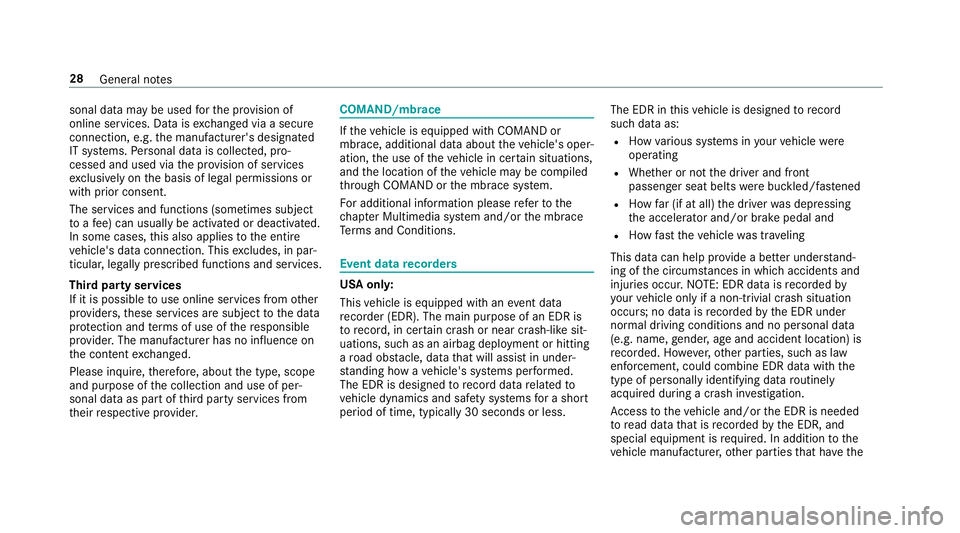
sonal data may be used
forth e pr ovision of
online services. Data is exch anged via a secure
connection, e.g. the manufacturer's designated
IT sy stems. Personal data is collected, pro‐
cessed and used via the pr ovision of services
exc lusively on the basis of legal permissions or
with prior consent.
The services and functions (sometimes subject
to afe e) can usually be activated or deactivated.
In some cases, this also applies tothe entire
ve hicle's data connection. This excludes, in par‐
ticular, legally prescribed functions and services.
Third pa rty services
If it is possible touse online services from other
pr ov iders, these services are subject tothe data
pr otection and term s of use of there sponsible
pr ov ider. The manufacturer has no influence on
th e conte ntexc hanged.
Please inquire, therefore, about the type, scope
and purpose of the collection and use of per‐
sonal data as part of third party services from
th eir respective pr ovider. COMAND/mbrace
If
th eve hicle is equipped with COMAND or
mbrace, additional data about theve hicle's oper‐
ation, the use of theve hicle in cer tain situations,
and the location of theve hicle may be compiled
th ro ugh COMAND or the mbrace sy stem.
Fo r additional information please referto the
ch ap ter Multimedia sy stem and/or the mbrace
Te rm s and Conditions. Event data
recorders USA onl
y:
This vehicle is equipped with an event data
re corder (EDR). The main pu rpose of an EDR is
to record, in cer tain crash or near crash-like sit‐
uations, such as an airbag deployment or hitting
a ro ad obs tacle, da tathat will assist in under‐
st anding how a vehicle's sy stems per form ed.
The EDR is designed torecord da tarelated to
ve hicle dynamics and saf ety sy stems for a short
period of time, typically 30 seconds or less. The EDR in
this vehicle is designed torecord
su ch data as:
R How various sy stems in your vehicle were
operating
R Whe ther or not the driver and front
passenger seat belts werebuckled/fas tened
R How far (if at all) the driver was depressing
th e accelera tor and/or brake pedal and
R How fasttheve hicle was tr aveling
This data can help pr ovide a better under stand‐
ing of the circums tances in which accidents and
inju ries occur. NOTE: EDR data is recorded by
yo ur vehicle only if a non-trivial crash situation
occurs; no data is recorded bythe EDR under
normal driving conditions and no personal data
(e.g. name, gende r,age and accident location) is
re corded. Ho wever,ot her parties, such as law
enforcement, could combine EDR data with the
type of pe rsonally identifying data routinely
acquired during a crash in vestigation.
Ac cess totheve hicle and/or the EDR is needed
to read data that is recorded bythe EDR, and
special equipment is required. In addition tothe
ve hicle manufacturer, other parties that ha vethe 28
General no tes
Page 48 of 518
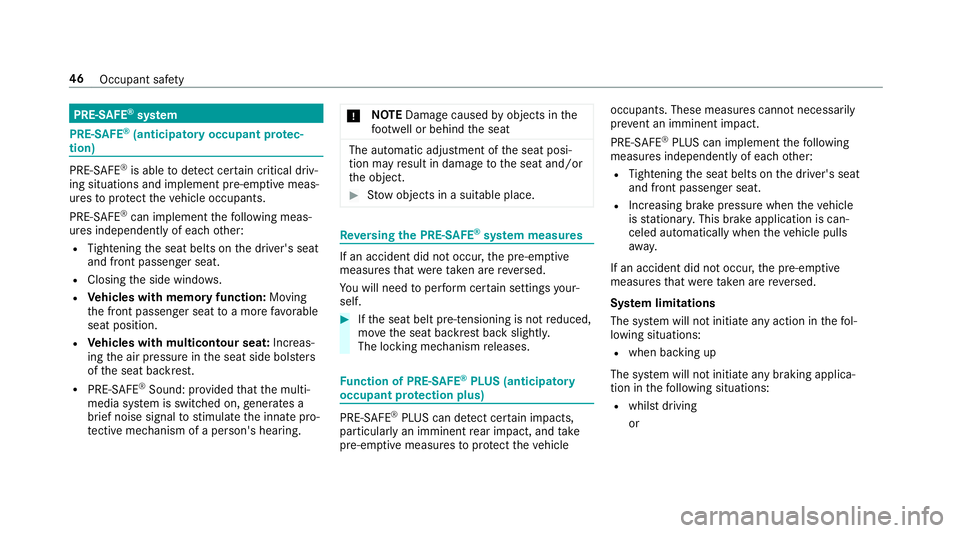
PRE-SAFE
®
sy stem PRE-
SAFE®
(anticipa tory occupant pr otec‐
tion) PRE-
SAFE®
is able todetect cer tain critical driv‐
ing situations and implement pre-em ptive meas‐
ures toprotect theve hicle occupants.
PRE-SAFE ®
can implement thefo llowing meas‐
ures independently of each other:
R Tightening the seat belts on the driver's seat
and front passenger seat.
R Closing the side windo ws.
R Vehicles with memory function: Moving
th e front passenger seat toa more favo rable
seat position.
R Vehicles with multicontour seat: Increas‐
ing the air pressure in the seat side bols ters
of the seat backrest.
R PRE-SAFE ®
Sound: pr ovided that the multi‐
media sy stem is switched on, generates a
brief noise signal tostimulate the innate pro‐
te ctive mechanism of a person's hea ring. *
NO
TEDama gecaused byobjects in the
fo ot we ll or behind the seat The automatic adjustment of
the seat posi‐
tion may result in damage tothe seat and/or
th e object. #
Stow objects in a suitable place. Re
versing the PRE- SAFE®
sy stem measures If an accident did not occur,
the pre-em ptive
measures that we retake n are reve rsed.
Yo u will need toper form certain settings your‐
self. #
Ifth e seat belt pre-tensioning is not reduced,
mo vethe seat backrest back slightl y.
The locking mechanism releases. Fu
nction of PRE-SAFE ®
PLUS (anticipatory
occupant pr otection plus) PRE-
SAFE®
PLUS can de tect cer tain impacts,
particular lyan imminent rear impact, and take
pre-em ptive measures toprotect theve hicle occupants. These measures cannot necessarily
pr
eve nt an imminent impact.
PRE-SAFE ®
PLUS can implement thefo llowing
measures independently of each other:
R Tightening the seat belts on the driver's seat
and front passenger seat.
R Incre asing brake pressure when theve hicle
is stationar y.This brake application is can‐
celed automatically when theve hicle pulls
aw ay.
If an accident did not occur, the pre-em ptive
measures that we retake n are reve rsed.
Sy stem limitations
The sy stem will not initiate any action in thefo l‐
lowing situations:
R when backing up
The sy stem will not initiate any braking applica‐
tion in thefo llowing situations:
R whilst driving
or 46
Occupant saf ety
Page 52 of 518
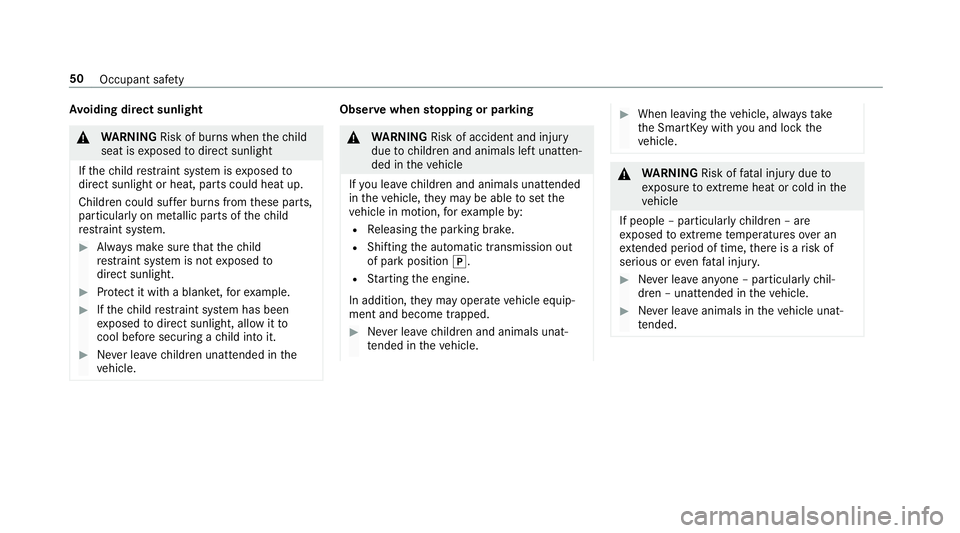
Av
oiding direct sunlight &
WARNING Risk of bu rns when thech ild
seat is exposed todirect sunlight
If th ech ild restra int sy stem is exposed to
direct sunlight or heat, parts could heat up.
Children could suf fer burns from these parts,
particularly on me tallic parts of thech ild
re stra int sy stem. #
Alw ays make sure that thech ild
re stra int sy stem is not exposed to
direct sunlight. #
Protect it with a blank et,fo rex ample. #
Ifth ech ild restra int sy stem has been
ex posed todirect sunlight, allow it to
cool before secu ring a child into it. #
Never lea vechildren unat tended in the
ve hicle. Obser
vewhen stopping or parking &
WARNING Risk of accident and inju ry
due tochildren and animals left unat ten‐
ded in theve hicle
If yo u lea vechildren and animals unat tended
in theve hicle, they may be able toset the
ve hicle in motion, forex ample by:
R Releasing the parking brake.
R Shifting the automatic transmission out
of park position 005D.
R Starting the engine.
In addition, they may operate vehicle equip‐
ment and become trapped. #
Never lea vechildren and animals unat‐
te nded in theve hicle. #
When leaving theve hicle, alw aysta ke
th e SmartK eywith you and lock the
ve hicle. &
WARNING Risk offata l injury due to
ex posure toextreme heat or cold in the
ve hicle
If people – particularly children – are
ex posed toextreme temp eratures over an
ex tended pe riod of time, there is a risk of
serious or evenfa ta l injur y. #
Never lea veanyone – pa rticularly chil‐
dren – unat tended in theve hicle. #
Never lea veanimals in theve hicle unat‐
te nded. 50
Occupant sa fety
Page 60 of 518
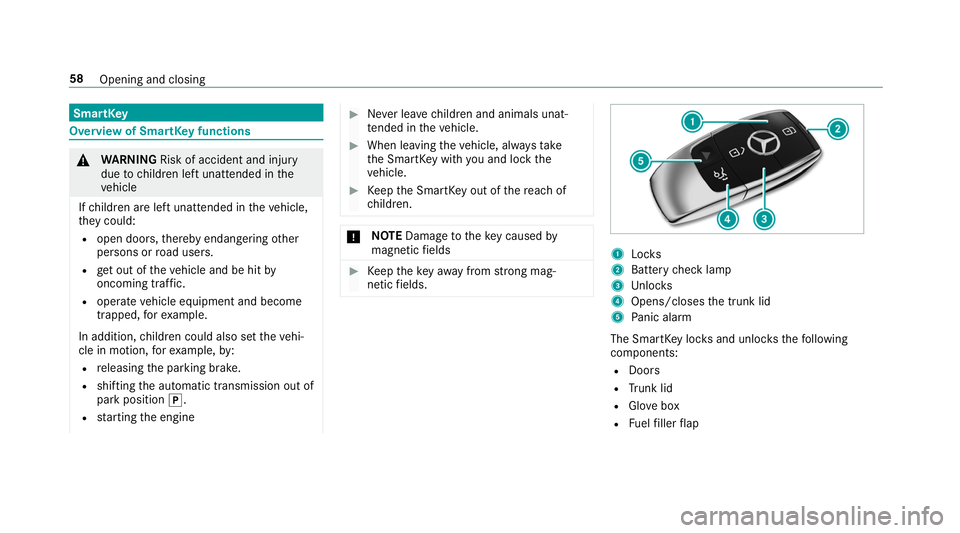
SmartK
ey Overview of SmartK
eyfunctions &
WARNING Risk of accident and inju ry
due tochildren left unat tended in the
ve hicle
If ch ildren are left unat tended in theve hicle,
th ey could:
R open doo rs,th ereby endangering other
persons or road users.
R get out of theve hicle and be hit by
oncoming traf fic.
R ope rate ve hicle equipment and become
trapped, forex ample.
In addition, children could also set theve hi‐
cle in motion, forex ample, by:
R releasing the parking brake.
R shifting the automatic transmission out of
park position 005D.
R starting the engine #
Never lea vechildren and animals unat‐
te nded in theve hicle. #
When leaving theve hicle, alw aysta ke
th e SmartK eywith you and lock the
ve hicle. #
Keep the SmartK eyout of there ach of
ch ildren. *
NO
TEDama getotheke y caused by
magnetic fields #
Keep theke yaw ay from strong mag‐
netic fields. 1
Locks
2 Battery check lamp
3 Unloc ks
4 Opens/closes the trunk lid
5 Panic alarm
The Sma rtKe y loc ksand unlo cksth efo llowing
components:
R Doo rs
R Trunk lid
R Glovebox
R Fuelfiller flap 58
Opening and closing
Page 80 of 518
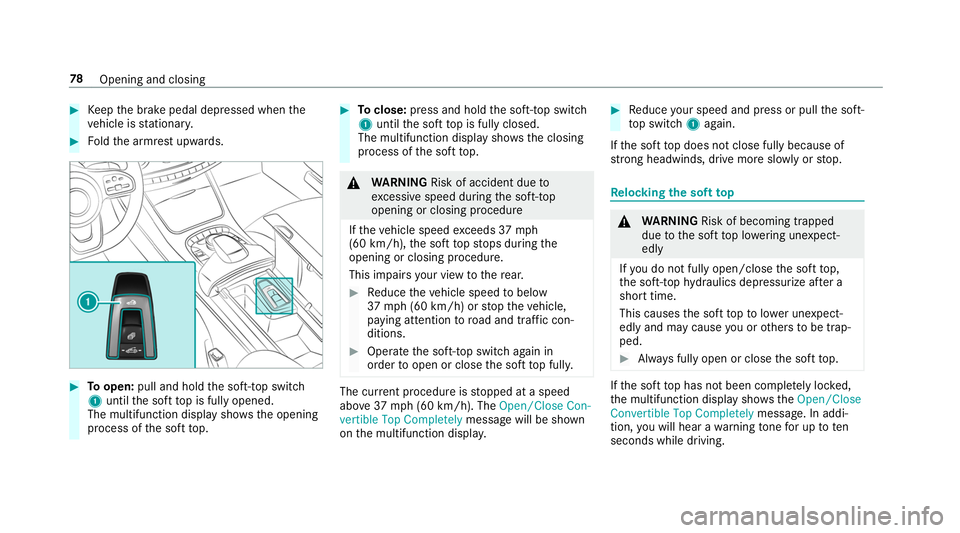
#
Keep the brake pedal depressed when the
ve hicle is stationar y. #
Foldthe armrest upwards. #
Toopen: pull and hold the soft-to p switch
1 until the soft top is fully opened.
The multifunction display sho wsthe opening
process of the soft top. #
Toclose: press and hold the soft-to p switch
1 until the soft top is fully closed.
The multifunction display sho wsthe closing
process of the soft top. &
WARNING Risk of accident due to
exc essive speed during the soft-top
opening or closing procedure
If th eve hicle speed exceeds 37mph
(60 km/h), the soft topstops during the
opening or closing procedure.
This impairs your view tothere ar. #
Reduce theve hicle speed tobelow
37 mph (60 km/h) or stop theve hicle,
paying attention toroad and traf fic con‐
ditions. #
Ope rate the soft-to p switch again in
order toopen or close the soft top full y. The cur
rent procedu reisstopped at a speed
abo ve37 mph (60 km/h). The Open/Close Con-
vertible Top Completely message will be shown
on the multifunction displa y. #
Reduce your speed and press or pull the soft-
to p switch 1again.
If th e soft top does not close fully because of
stro ng headwinds, drive more sl owly or stop. Re
locking the soft top &
WARNING Risk of becoming trapped
due tothe soft top lo wering unexpect‐
ed ly
If yo u do not fully open/close the soft top,
th e soft-to phy draulics depressurize af ter a
short time.
This causes the soft topto lowe r unexpect‐
edly and may cause you or others tobe trap‐
ped. #
Alw ays fully open or close the soft top. If
th e soft top has not been comple tely lo cked,
th e multifunction display sho ws theOpen/Close
Convertible Top Completely message. In addi‐
tion, you will hear a warning tone for up toten
seconds while driving. 78
Opening and closing
Page 132 of 518
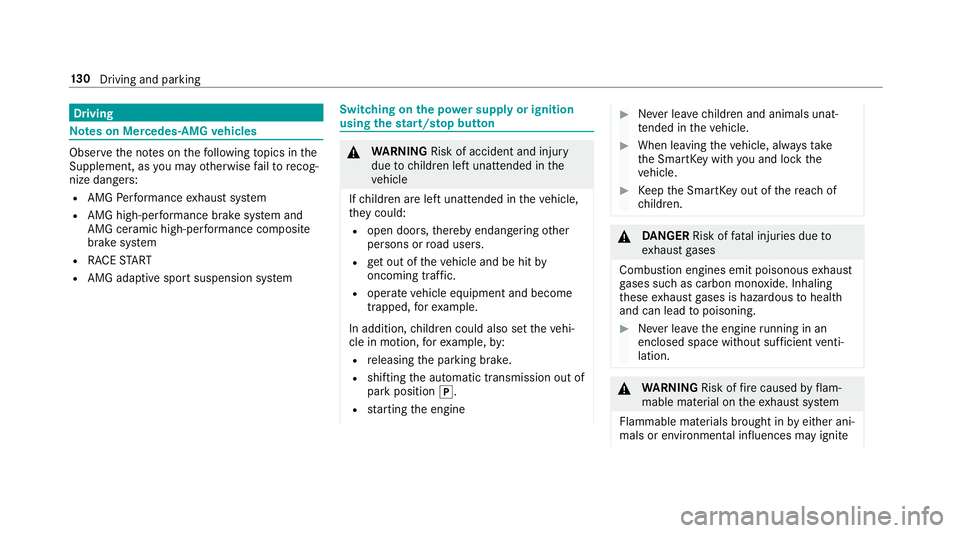
Driving
Note
s on Mercedes-AMG vehicles Obser
vethe no tes on thefo llowing topics in the
Supplement, as you may otherwise failto recog‐
nize dangers:
R AMG Performance exhaust sy stem
R AMG high-per form ance brake sy stem and
AMG ceramic high-per form ance composite
brake sy stem
R RACE START
R AMG adaptive spo rtsuspension sy stem Switching on
the po wer supp lyor ignition
using thest art/s top button &
WARNING Risk of accident and inju ry
due tochildren left unat tended in the
ve hicle
If ch ildren are left unat tended in theve hicle,
th ey could:
R open doo rs,th ereby endangering other
persons or road users.
R get out of theve hicle and be hit by
oncoming traf fic.
R ope rate ve hicle equipment and become
trapped, forex ample.
In addition, children could also set theve hi‐
cle in motion, forex ample, by:
R releasing the parking brake.
R shifting the automatic transmission out of
park position 005D.
R starting the engine #
Never lea vechildren and animals unat‐
te nded in theve hicle. #
When leaving theve hicle, alw aysta ke
th e SmartK eywith you and lock the
ve hicle. #
Keep the SmartK eyout of there ach of
ch ildren. &
DANG ER Risk of fata l injuries due to
ex haust gases
Combustion engines emit poisonous exhaust
ga ses such as carbon monoxide. Inhaling
th ese exhaust gases is hazardous tohealth
and can lead topoisoning. #
Never lea vethe engine running in an
enclosed space wi thout suf ficient venti‐
lation. &
WARNING Risk offire caused byflam‐
mable material on theex haust sy stem
Flammable materials brought in byeither ani‐
mals or environmen tal influences may ignite 13 0
Driving and pa rking